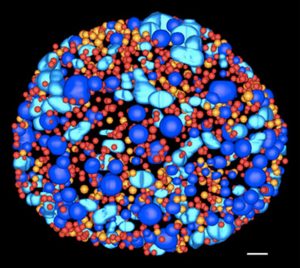Suetterlin, Tan and Enciso labs publish in Nature Communications
Chlamydia size matters

A collaboration between the Suetterlin, Tan and Enciso labs, which are located in UCI’s Schools of Biological Sciences, Medicine and Physical Sciences, respectively, as well as the National Center for Microscopy and Imaging Research at UC San Diego resulted in a publication in Nature Communications. Lead author was a joint Ph.D. student in the Suetterlin and Tan labs, who was assisted by two UC Irvine undergrads and two high school students from the community. The study focused on the Chlamydia inclusion, which is the compartment within an infected human cell that is inhabited by the obligate intracellular bacterium Chlamydia. Infection with Chlamydia is the most common bacterial sexually transmitted infection and the most reported infectious disease in the U.S. Using a 3D electron microscopy approach that is similar to a CT scan, the authors measured the number and size of all chlamydial developmental forms. They observed repeated division of the non-infectious reticulate body (RB) prior to the asynchronous conversion of the RB into the infectious elementary body (EB) for release to infect a new host cell. They also found that RBs get smaller by six-fold over successive rounds of chlamydial cell division, unlike other bacteria, which maintain their cell size when they divide. This unexpected result led to a novel model in which the reduction in chlamydial size through replication controls the timing of conversion into the infectious form. This size control model was supported by mathematical and computational modeling, showing that size control is sufficient to reproduce the observed dynamic balance between replication and conversion, without the need for an external signal.
Link to the paper: http://rdcu.be/DYCQ
Accompanying Behind the Paper piece in Nature Microbiology Community: https://naturemicrobiologycommunity.nature.com/channels/346-behind-the-paper/posts/28982-size-matters-for-chlamydia


